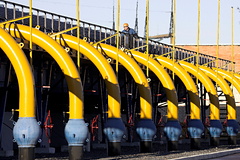Deputy Prime Minister Novak lists the main reasons for the rise in gas prices in Europe

Photo: Vasily Fedosenko / Reuters
Russian Deputy Prime Minister Alexander Novak named the main reasons for the gas crisis in Europe. He told about this in an interview with RBC.
He pointed out that the European Commission is “purposefully” abandoning long-term contracts in favor of spot contracts. The politician explained that the spot does not allow predicting the medium and long term in the market. As a result, in the summer, European countries were faced with a situation where they were unable to fill storage facilities, as gas went to more economically favorable markets.
In addition, the last cold winter influenced the rise in prices. Then, due to low temperatures, the time for pumping into underground storage facilities was reduced by three weeks, and this did not make it possible to compensate for the difference between the withdrawn 66 billion cubic meters of gas and the injected 47.8 billion cubic meters.
TTF1 Quotes! by TradingView
The risks of a repeat of the cold winter are also affecting futures. However, this is “a common market story,” Novak pointed out.
In conclusion, the Deputy Prime Minister noted that Europe began to produce less of its own gas, thereby giving up long-term investments in the industry. Since the banks were advised not to finance traditional hydrocarbon projects, the development of new fields is not being carried out, and an even greater gas shortage should be expected in the future.
Gas reserves in Europe have depleted after the Russian supplier stopped booking additional capacities for gas transit via the Yamal-Europe gas pipeline to Germany from 21 December. According to Gazprom, European buyers do not make bids themselves. Due to the freezing of supplies, the price of gas in Europe for the first time in history exceeded $ 2,150 per thousand cubic meters.
After that, the United States came to the aid of the EU: over the weekend, December 25 and 26, the country increased the supply of LNG to the region by a third. According to Bloomberg calculations, at least seven other ships sailing to Asia were reoriented to Europe, and the Financial Times had previously drawn attention to the trend.
Later, the cost of fuel went down, but remains relatively high. On December 28, January futures are trading around the $ 1,200 per thousand cubic meter mark, according to London-based ICE data.

